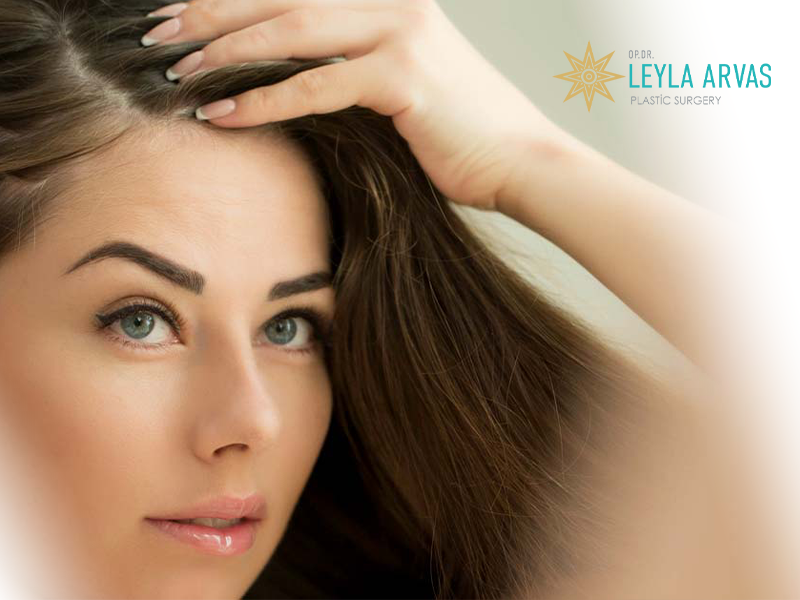In particular, nowadays, hair transplantation for women is one of the most often requested treatments for the problem of hair loss, which is brought on by stress, an increasingly unhealthy diet, and hormonal issues. These issues make it impossible to avoid hair loss, which over time leads to thinning and eventually the problem of baldness. On Dr. Leyla.com, you can get all the information you need about hair transplantation for women, a treatment used to address the hair loss issue that has a detrimental impact on both women’s psychology and self-confidence.

Men’s hair transplantation is the first thing that everyone thinks of when discussing hair transplantation. Women today demand hair transplants just as much as men do. Female pattern hair loss or forehead narrowing can be treated with hair transplantation, which results in the growth of bushy, healthy hair strands. It is advised to begin hair transplantation treatment right away if your hair is thinning and there are localized gaps in it. A hair transplant may be significantly more challenging or even impossible if all of your hair has been lost.
Hair transplantation for women is similar to that in men, but there are a few key differences. Women typically experience hair loss differently than men, with thinning occurring more evenly across the scalp rather than a receding hairline or bald patch. Therefore, hair transplantation for women may involve a larger area of the scalp, and the procedure may be more challenging to perform due to the nature of female hair loss.
What Is Hair Transplantation for Women?
Treatments for hair transplants are evolving quickly every day. In hair transplant procedures for women, it is no longer essential to shave hair. Hair transplantation has done away with the need for women to shave their heads, which has turned into a terrifying nightmare. Instead, the FUE procedure is used to do hair transplantation in a completely aesthetically pleasing manner. Hair follicles were harvested during the old, traditional hair transplant procedure by shaving a window-like area for women’s napes. The hair to be transplanted is collected one by one in the neck and moved to the area where hair loss is present using the FUE technique currently in use. It is not immediately apparent that people have hair transplants because the hair is not shaved during this transplant.
Single, double, and triple hair follicles are removed from the donor area and transferred one at a time to the recipient area throughout the operation. By using the FUE technique to remove the hair follicles as single, double, or triple units instead of cutting them into strips, on the one hand, it creates a natural and luxuriant hair appearance while, on the other, removing the chance of scarring after the treatment.
What Causes Hair Loss for Women?
Women’s hair loss can be caused by a variety of factors. Malnutrition, stress, and hormonal fluctuations are a few of them. The condition of a woman’s hair is very significant. This is why you should seek medical attention right away if you notice hair shedding that has an impact on your mental health. With today’s evolving technology, women’s hair loss can be treated, and thick hair can be restored.
Female pattern hair loss can have many distinct causes, and if these problems are not addressed quickly, the person may eventually be left alone with their baldness issues. The most typical ailments that result in hair loss for women include;
- Hormonal imbalances
- Genetic propensity
- Stress and mental health issues
- Adverse effects of certain commonly used medications include irregularity and malnutrition
- Pregnancy
- Menopause
- Using improper shampoo and conditioner
- Applications that harm hair, such as perms and permanent blow drying
- Continual hair pulling
Male pattern hair loss can also affect certafor women. The hairline recedes in the forehead region and an opening can be observed on top in androgenetic alopecia, a type of male pattern hair loss. Hair transplantation can be used to treat the issue of male pattern hair loss for women.
How To Treat Hair Loss for Women?
Unfortunately, applying cosmetic products at home won’t stop female hair loss. While hair mesotherapy stops hair loss when used by a specialist, there is no other option for situations of openness and severe shedding in the upper region other than hair transplantation.
What Makes Hair Transplantation for Women Different?
Women undergo hair transplantation in a different way than men do. Before doing an FUE hair transplant on a man, the hair is first shaved. This makes it simple to transplant hair follicles from the donor location to the receiving area. But, female patients’ hair is left unshaven so that they can comfortably go about their regular activities. In order to avoid drawing attention to the procedure, the donor place for hair transplantation is the easily-masked nape of the neck.
How Does Hair Transplantation for Women Work?
Women who need hair transplants get the procedure done using the FUE method. The patient is thoroughly assessed prior to the treatment to determine his suitability for hair transplantation. The application region is then given a local anesthetic before the surgery if hair transplantation is chosen. In this manner, the patient experiences no discomfort whatsoever throughout the process. First, healthy hair follicles from the patient’s nape are retrieved as single, double, and triple units utilizing the FUE procedure. The channels that have been opened in the recipient location are then transferred with these collected hair follicles. The full transplantation procedure is finished in an average of 6-8 hours, though it varies from person to person based on the amount of graft needed by the location where thinning and baldness develop.
The patient can return home after the procedure. All the instructions provided by the doctor should be strictly adhered to in order to avoid damaging the newly transplanted hair follicles and to ensure a successful treatment. On the designated day, if necessary, the patient returns to the clinic for dressing and initial washing. It is returned to normal life on average 10 days following the treatment.
Things To Consider After Getting Hair Transplantation for Women
Considerations following hair transplantation for women are similar to those after hair transplantation for males. Following hair transplantation, you should relax for three days and refrain from doing any strenuous activity. If at all possible, experts in the clinic where the surgery was performed should perform the initial washing process after the procedure. In the event that this is not possible, the patient should strictly adhere to the washing instructions and use only the products the doctor has prescribed.
It is advised to lie in a position that won’t harm the freshly established roots during the healing process. It is not advisable to touch, pluck, or scratch the crusts that form in the hair follicles, especially in the first week following the operation. They will eventually fall off on their own, as is to be anticipated. Just the approved items should be utilized up until the doctor’s specified date; alternate cosmetic and care products should not be used.
Very hot conditions should be avoided, as should excessive heat styling tools like curling irons and blow dryers in order to prevent harming the hair follicles. Scarves, bandanas, and hats should not be worn in a way that puts pressure on the area where the hair transplant was performed until the healing process is complete. Once more, the head area should not be directly exposed to the sun’s damaging rays until the healing process is complete.
Following hair transplantation, the first dyeing procedure should be carried out with the doctor’s knowledge. Wait until the doctor says it is OK to move about freely after the control examination.
Possible Risks And Side Effects Of Hair Transplantation for Women
If carried out by qualified medical professionals with experience in hair transplantation for women, it is a risk-free procedure with only very few adverse effects. Throughout the first week following the operation, it’s pretty common to experience some little swelling where the application was made as well as redness and crusting in the nape area. These minor side effects quickly disappear on their own. Without satisfying all of these requirements, hair transplantation may have irreversible dangers and negative effects. For instance, if the required hygiene standards are not fulfilled, hair follicles may contract an infection or permanent baldness may develop in the donor area as a result of over-removing hair follicles.
Do You Need To Shave Your Head For Hair Transplant for Women?
Treatments for hair transplants are evolving quickly every day. In hair transplant procedures for women, it is no longer essential to shave hair. Hair transplantation has done away with the need for women to shave their heads, which has turned into a terrifying nightmare. Instead, the FUE procedure is used to do hair transplantation in a completely aesthetically pleasing manner. Hair follicles were harvested during the old, traditional hair transplant procedure by shaving a window-like area for women’s napes. The hair to be transplanted is collected one by one in the neck and moved to the area where hair loss is present using the FUE technique currently in use. It is not immediately apparent that people have hair transplants because the hair is not shaved during this transplant.
Does Hair Transplantation Lower Hairline for Women?
Hair transplantation on the crown area of females, where shedding and thinning occur, and on the areas that cause clarity in the forehead area are simple procedures. The forehead region may physically be wider than usual or it may have opened up following the shedding issue. In this instance, the ratio of the face’s overall appearance deteriorates. In these situations, hair transplantation is done in the direction that the hair grows to produce the desired lush hair appearance and to permanently balance the face appearance, with good outcomes.
Does Hair Transplantation for Women Leave Scars?
The FUE procedure is typically used for performing hair transplants on female patients. Instead of being sliced into strips like in the FUT technique, the hair follicles removed from the donor area are removed as single, double, or triple units and transported to the desired area during the transplantation procedures. This reduces the chance of scarring following the surgery.
Hair Transplantation for Women Prices
One of the procedures that Quartz Clinic does the most frequently on women is hair transplantation. The cost of hair transplantation for women varies greatly depending on the quantity of transplanting required, the number of sessions to be used, the technique used, the doctor’s experience, and the caliber of the clinic. Moreover, the Ministry of Health’s approved facilities is not permitted to list costs on their websites. Due to this, our patients can contact our clinic at 02122414624 for more information and to schedule an appointment if they want to find a long-term solution to their hair loss, thinning, and balding issues.
